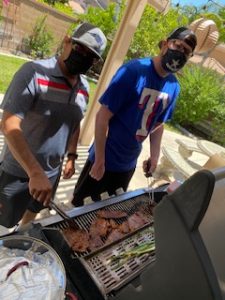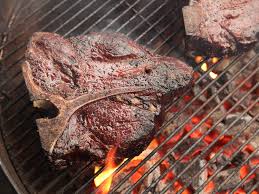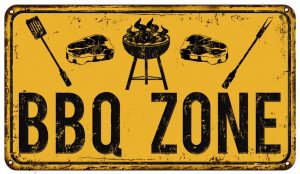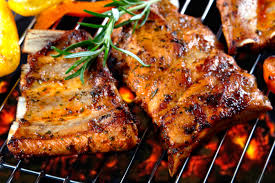Grilled ribeye seems to be that perfect, delicious steak every dad loves. Whether it’s Father’s Day or not, you can always fire up the grill and make yourself (or your special man) a nice steak.
But is grilled ribeye easy to make ? It certainly seems to be in high demand, you would guess so.
Let’s find out just how easy it is to grill ribeye, and how to do it right.
What cut of meat to use for ribeye steak
Ribeye comes with several other names, and I think we should really clear things up before we get anywhere close to the grill.
First, let’s settle what ribeye is, and where it is on the animal.
As you might’ve guessed, it’s a cut of meat from the rib area. It’s actually the upper rib cage, and that part of the animal doesn’t get very much exercise.
This results in a comparatively tender muscle, since the less exercise the animal gets, the more tender the meat. It’s also why younger cattle are sacrificed, as opposed to older specimens.
Older cattle have moved around more, meaning they’ve got firmer muscles, and the overall age toughens the meat as well.
So, ribeye is either with or without the rib (bone). Most commonly you’ll find it without the bone, and for the purpose of a steak that’s great.
The bone does add flavor, if you’re making a stew. But on a steak it will just warp the meat.
In terms of thickness, too thick or too thin are a thing. The best cut is 1.25 inch cuts. Thinner will cook too fast and will dry out/toughen. Too thick will result in an imbalance between the center and the outer layer.
And there are 3 types of ribeye you can get. The first, and also the best, is ‘prime’. This is the most expensive, but will also have the nicest marbling and thus better flavor.
Second, you can get ‘choice’ which is the most common one. Also good marbling, but not as great as prime.
Finally, there is ‘select’, which is often a poor cut but can do in an emergency or if you have nothing else on hand.
Marbling matters
The fat content on the inside of the cut is what’s going to give your grilled steak more flavor.
The way a ribeye is arranged, it will have tiny lines of white fat, like a sort of spiderweb, just going everywhere. This keeps the meat tender, as the tiny amounts of fat prevent it from getting too dry.
And the marbling also carries flavor of its own, meaning a lean steak will be less flavorful than a well marbled one.
Now this is where the difference between prime and choice and select comes in.
The best cut (prime) is going to have the best marbling, as tiny, thin lines of fat that that are everywhere in the meat. This leads to tender, flavorful steaks.
The lower the rating, the less fine the marbling. Or even less marbling overall.
So if you’re planning on getting ribeye steaks for an occasion, know that prime is best, but you’ll be paying extra. If that’s a little much, then choice should do the job well enough.
How to grill a perfect ribeye steak

Alright, now that you know what you need to get when wanting to grill a nice ribeye steak, you’re going to want to know just how easy it is to grill the thing.
I’ll help you out, starting with how hot to heat your grill.
No matter what kind of grill you use, try and get it to 400-450 F. On some grills this is close to the maximum, and on some it could be halfway.
Best to use an instant read thermometer.
Heating the grill will take a while, and once it’s heated, it should stay that way for 10-15 minutes before you start grilling.
While the grill heats, you should prep the steaks. Now, the meat should be at almost room temp. This means that you should take it out of the fridge about 30-60 minutes before you grill it.
Warmer steak (but not 80 F) will cook easier, but too warm a raw steak can cook too fast and lead to a very tough meat even if you used the correct time.
If you steak has any thick fat on the side, trim it off. That particular fat will only melt away and cause flare ups which can char your steak more than you want.
When preparing the steak, a simple salt and pepper rub will do. The overall flavor of steak is great on its own, no need to add anything else.
No one’s going to stop you from adding extra seasoning, though.
So generously rub the steak with salt and pepper, both coarsely ground. If you want, you can set aside a small piece of butter to place on top of the steak when it’s done and plated.
Once the steak is seasoned, and the grill is hot enough, place it on the grill.
Since ribeye has good marbling, and some fat on the side to begin with, there should be no need to oil the grates.
First let the ribeye sit on the grill for 6 minutes. If you’d like crosshatch marks (you know you do), turn the steak sideways on the grate at the 3 minute mark.
Once it’s got 6 minutes, flip it on the other side and use a meat thermometer. You’re going to want to go read the temperature when grilling beef, so these stats will help you out:
- Medium-rare 134-140 F
- Medium 140-150 F
- Medium well 150-155 F
- Well done 160-212 F
Whichever degree of doneness you like, be sure to get as close as possible to the desired internal temp reading.
Once the ribeye steak is at the point you want it to be, remove from heat. This could mean a total of 10 minutes, even 12. It all depends on the temperature of the steak when you put it on the grill, and the thickness of the cut.
Do keep in mind that once you take the meat off the grill, it will need to rest for 5-10 minutes. The temperature will rise about 5 degrees then, don’t worry about that.
The steak needs rest so the juices redistribute (as the meat cooks it contracts), meaning it will be juicier and more tender if you let it rest a little.
Use aluminium foil to cover the steak loosely while you arrange the table and get ready to plate the ribeye.
Tips on grilling ribeye (or beef in general)

A few tips will always help keep you ahead of the game (grill ?) when you’re grilling beef, since it can be a bit tricky to deal with.
All red meats are tricky since they need you to keep an eye on internal temperature, rather than how the meat looks or smells.
In time you’ll learn to associate the proper look and smell of a beautifully grilled steak, but until then a thermometer will be your best friend.
Always use a thermometer
A meat thermometer is always going to be necessary when cooking any kind of beef, ribeye or not.
You can better rely on the internal temperature of the meat than the outside/appearance of the steak.
This is especially true if you’re still an inexperienced grill master, and in this case you’re going to learn to love this thing.
Most thermometers are easy to find, and fairly cheap as well. A cursory look online will give you a good range of results.
For example the one I recommend is the ThermoPro TP-07 Wireless Remote, which has one piece (the needle) that inserts into the meat and reads the temperature, and another which will display the reading.
It’s got several useful settings and measurements, and all of them will help you get the best grilled ribeye. For example:
- The display changes color as the meat gets close to ‘done’
- Has pre-programmed, USDA approved temperatures for safely cooking meat
- Alarm goes off when the meat is done
- Wide use range, 300 feet
- Wireless, hence the wide range
You can check more about this thermometer on my Recommended Gear page, under Best Grill Thermometer. You’ll find out what other features it has, and just how useful it can be.
Preheat your grill for at least 15 minutes
Preheating the grill, and thus having it be screaming hot when you put the meat on will mean much less sticking to the grate than if you used a cold or lukewarm grill to begin with.
It’s also going to ensure that you get consistent, even temperature when grilling, from start to finish. This is going to help a lot in getting you the best possible steak.
It’ll also help you keep an eye on internal temp easier, especially if you’re grilling your first steaks ever.
Let raw steak rest at room temp before grilling
If you place cold, cold meat on the hot grill, the severe temperature difference is going to take a toll on how well your steak is grilled.
The outer layer of the steak’s going to be a confused, semi-burnt mess, while the inside will remain more than pink.
You’ll be left with a cold, completely uncooked center, which is no fun even for those who prefer rare steaks.
If you let the steak rest too long before grilling it, you risk getting it too warm, and as such it will grill too fast, and get done quicker than you’d either expect or would be able to manage for a good flavor.
Your best bet is getting the steak out of the fridge about 30 minutes (but under an hour) before grilling.
In any case, never put cold meat on the grill !
Conclusion
Grilling ribeye is going to be easy enough if you have a meat thermometer. You’ll get the readings you need, and you’ll be able to follow pretty much any instructions you can find on how to grill ribeye, since all of them mention internal temperatures.
So, you should find it easy enough. Still, if it’s your first time grilling ribeye and it doesn’t quite come out good, don’t worry. We all learn, and the best part about grilling is that your trials and errors will (usually) be delicious.




